
as shallow-water blackout, which can be deadly.
This is an issue DAN® researchers and physicians
have written about often, and it’s why freedivers
should always work in buddy teams.
The topic was recently addressed in the
Expert Opinions article of the Spring 2013
issue of Alert Diver, which can be found online
at AlertDiver.com/brain. In the article, Kay
Tetzlaff, M.D., spoke to the effects of reduced
oxygenation of the brain with repeated breath-
hold dives, observing, “Extreme apneas as
performed by elite breath-hold divers cause
significant stress on the cardiovascular and
respiratory systems. It should be noted that
extreme breath-hold diving is a dangerous
activity that can cause serious health hazards,
among which long-term brain damage is the least
worrisome.” That being said, I’m not talking about that
kind of freediving in this article. Here I am focusing on
freediving that’s well within the personal limits of the
shooter and is intended to provide a way to photograph
subjects not easily accessible by other means.
DRESS FOR SUCCESS
While good fitness provides the biggest and most
obvious boon to successful freediving, appropriate
wardrobe selection is an easy way to improve efficiency.
On a trip to Dominica to photograph sperm whales
last winter I was surprised how few in our group had
swapped their normal dive gear for more hydrodynamic
equipment. Thick neoprene wetsuits that would keep
a diver warm for an hour on the bottom provided too
much buoyancy on the surface. The divers wearing
these suits had to wear weights to even get below the
surface, and so much effort was expended to defeat
buoyancy that their dives were shallow, brief and tiring.
Some of the divers used fins that were likewise good
for scuba diving but didn’t provide the immediate
thrust and propulsion needed to dive under the water
and get to speed quickly. Even accepting that we aren’t
supposed to chase the whales, a barely perceptible fin
motion by a whale or a dolphin grants so much more
speed than even the fastest swimmer; to even have a
possibility of a fleeting encounter requires powerful fins
and good technique.
Low-volume masks that are easy to clear and provide
minimal drag are best, and streamlined snorkels are
definitely preferred. The snorkel in this scenario is
for breathing on the surface; experienced freedivers
will let the snorkel hang by the keeper during the dive
(reinserting it on the surface) rather than keeping it
clenched in their teeth the whole time. Some even
tuck it away in their weight belt until it’s needed.
Different certification agencies will recommend
different techniques, but I‘m sure all would agree that
streamlined gear makes for more successful freediving.
Many manufacturers now offer lines of apnea gear
that include special masks, fins and snorkels as well as
smooth-surfaced wetsuits that minimize drag while
still providing thermal protection. Don’t assume that
your familiar scuba gear is necessarily up to the task of
delivering a quality freedive experience.
FINE-TUNE YOUR CAMERA GEAR
Bigger is not necessarily better in freedive
photography. Many shooters are embracing smaller
camera systems with less drag for this purpose.
Compact cameras and housings are a fine solution if
they don’t induce significant shutter lag. Capturing
peak action on a breath-hold requires a system
that will acquire focus quickly and be immediately
responsive to the press of the shutter. Many large
marine mammals are uniform in color, lacking
the contrast that makes autofocus work easily, so
advanced focus-acquisition technology is preferred.
The new wave of mirrorless cameras includes
excellent options for freediving; the form factors of
their housings are small, yet these cameras provide
large sensors and capture excellent files without
significant shutter lag. In his recent Shooter profile
in Alert Diver (Summer 2013), Alex Mustard said,
“Lately I have also been experimenting with Olympus’
two-times-crop mirrorless cameras, whose small size
|
101
MARKO DIMITRIJEVIC
In some situations access to marine life is restricted to
snorkeling, as with the whale sharks off Isla Mujeres.


